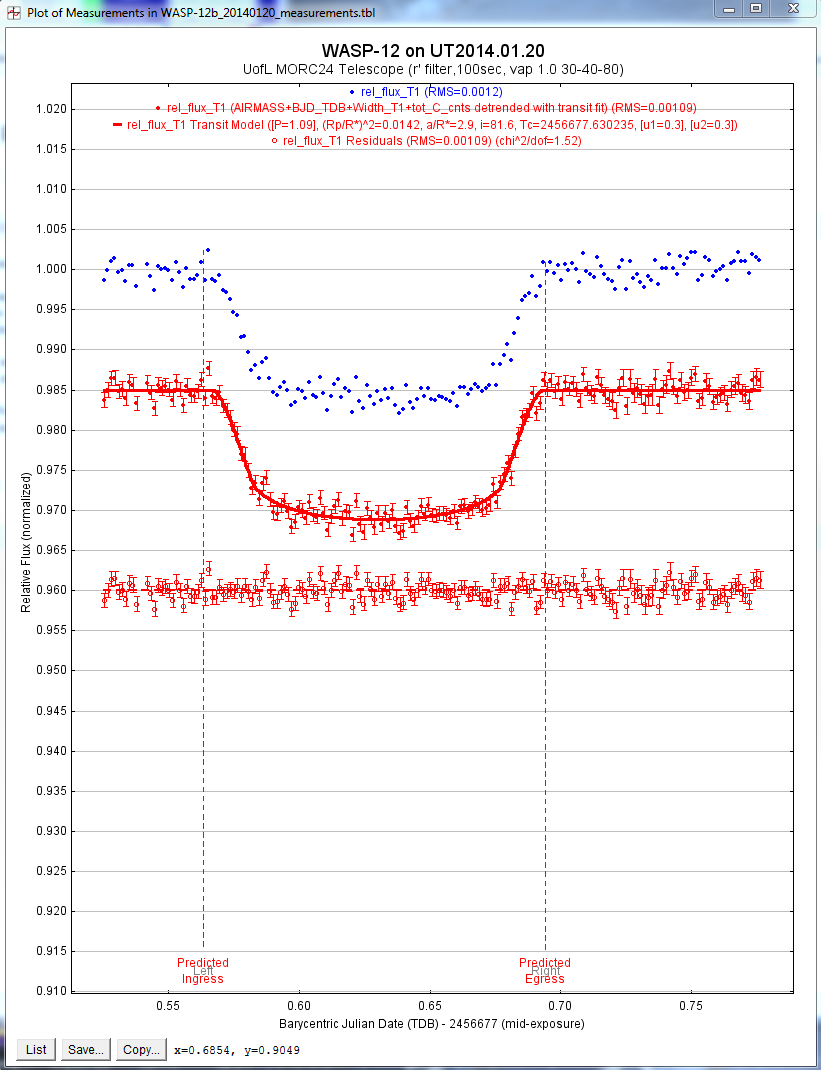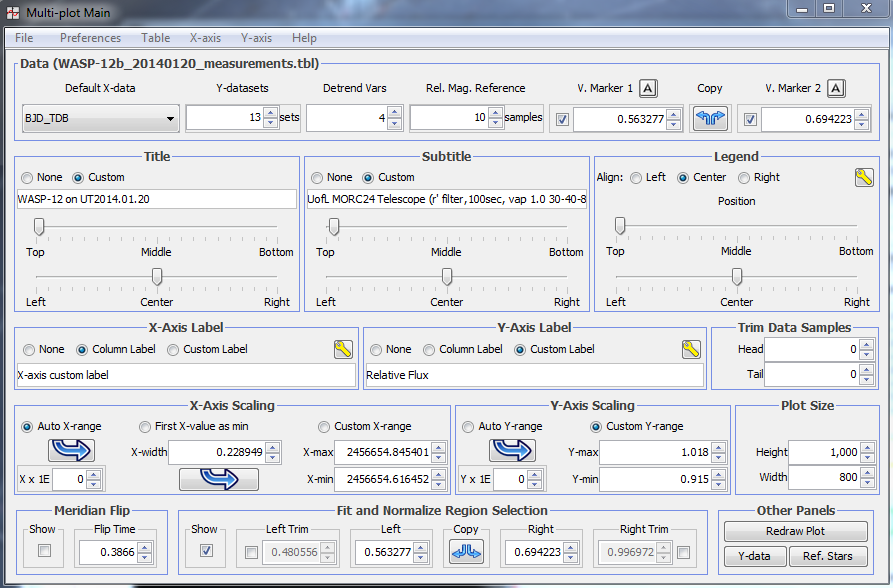Re: Transit Fitting plus referencing software in paper
Posted by karenacollins on Dec 16, 2014; 8:03am
URL: http://astroimagej.170.s1.nabble.com/Transit-Fitting-plus-referencing-software-in-paper-tp199p200.html
Hi David,
Yes, the transit fitting algorithm uses the Mandel and Agol (2002) algorithm. There is currently no paper to reference, but you can reference either Karen Collins & John Kielkopf, 2015, in prep, or you can reference the Astrophysics Source Code Library entry ascl:1309.001 (http://ascl.net/1309.001) (Bibcode: 2013ascl.soft09001C).
Unfortunately, there is currently no written guide for the use of the transit fitting routine in AIJ. Hopefully, updates to the guide will happen over over the next several weeks.
To get you started for now, you can access the feature by going to the Multi-plot Y-data panel and selecting the bottom most "Fit mode" (looks like a transit light curve):

That will cause the fitting setup panel to open for that light curve. Here is an example setup for a WASP-12b observation:

As long as "Auto update Priors" is selected (the default), you really only need to enter the orbital period at the top left of the fit setup panel, and on the bottom row of the 'Multi-plot Main' panel, set the "Fit and Normalize Region Selection" 'Left' setting near the ingress time on the plot (shortcut is <Cntrl>-left-click on the plot), and the 'Right' setting near the egress time (shortcut is <Cntrl>-right-click on the plot). Then select any desired detrending parameters below the fit parameters.
The fit will work in most cases with only those settings.
The only remaining information that can help to pinpoint the fit is the starting point (or 'Prior Center' setting) for the Quad LD u1 and u2 parameters (i.e. quad limb darkening parameters). If you don't have spectroscopic data for the host star (Teff, [Fe/H] and logg), for ground based data, it is probably good enough to 'lock' both prior center values of u1 and u2 to 0.3 (or maybe lock one of them to 0.3 and the other to 0.0). You may also try unlocking one of them to see what the fit finds. If you have the three spectroscopic parameters mentioned above , use the web site below to calculate theoretical values to use for u1 and u2 based on the filter used for the observations.
http://astroutils.astronomy.ohio-state.edu/exofast/limbdark.shtml
If your transit is a known exoplanet, look at http://exoplanets.org to find the spectroscopic parameters to use on the above webpage. For ground-based data, it is probably best to lock u1 and u2 to the theoretical values from the webpage, but you can always unlock one or both to see if the fit improves significantly. If one of the values runs away to something near 1.0 or -1.0, you should probably lock that value to the theoretical value.
If you want to have the planetary radius estimated, you will need to enter one of the "Host Star Parameters' at the top right of the fit setup panel. The best estimate will be provided in the Rp (Rjup) box if you can find an estimate for host star radius (R*) and enter that directly in the 'Host Star Parameters'.
Prior Width and Step Size are advanced settings and are not normally needed, especially for full transit observations.
Also, make sure the "Show Tooltips Help' option is enabled on the 'Multi-plot Main' panel 'Preferences' menu while you are becoming familiar with the tool. When that option is enabled, most options on the fit setup panel show additional information in a popup that shows when mousing over any settings box.
Let me know if you have specific questions and I will try to answer them here.
Here is a plot generated for the WASP-12b example given above:

and the associated Multi-plot Main and Multiplot Y-date settings:


Karen
URL: http://astroimagej.170.s1.nabble.com/Transit-Fitting-plus-referencing-software-in-paper-tp199p200.html
Hi David,
Yes, the transit fitting algorithm uses the Mandel and Agol (2002) algorithm. There is currently no paper to reference, but you can reference either Karen Collins & John Kielkopf, 2015, in prep, or you can reference the Astrophysics Source Code Library entry ascl:1309.001 (http://ascl.net/1309.001) (Bibcode: 2013ascl.soft09001C).
Unfortunately, there is currently no written guide for the use of the transit fitting routine in AIJ. Hopefully, updates to the guide will happen over over the next several weeks.
To get you started for now, you can access the feature by going to the Multi-plot Y-data panel and selecting the bottom most "Fit mode" (looks like a transit light curve):

That will cause the fitting setup panel to open for that light curve. Here is an example setup for a WASP-12b observation:

As long as "Auto update Priors" is selected (the default), you really only need to enter the orbital period at the top left of the fit setup panel, and on the bottom row of the 'Multi-plot Main' panel, set the "Fit and Normalize Region Selection" 'Left' setting near the ingress time on the plot (shortcut is <Cntrl>-left-click on the plot), and the 'Right' setting near the egress time (shortcut is <Cntrl>-right-click on the plot). Then select any desired detrending parameters below the fit parameters.
The fit will work in most cases with only those settings.
The only remaining information that can help to pinpoint the fit is the starting point (or 'Prior Center' setting) for the Quad LD u1 and u2 parameters (i.e. quad limb darkening parameters). If you don't have spectroscopic data for the host star (Teff, [Fe/H] and logg), for ground based data, it is probably good enough to 'lock' both prior center values of u1 and u2 to 0.3 (or maybe lock one of them to 0.3 and the other to 0.0). You may also try unlocking one of them to see what the fit finds. If you have the three spectroscopic parameters mentioned above , use the web site below to calculate theoretical values to use for u1 and u2 based on the filter used for the observations.
http://astroutils.astronomy.ohio-state.edu/exofast/limbdark.shtml
If your transit is a known exoplanet, look at http://exoplanets.org to find the spectroscopic parameters to use on the above webpage. For ground-based data, it is probably best to lock u1 and u2 to the theoretical values from the webpage, but you can always unlock one or both to see if the fit improves significantly. If one of the values runs away to something near 1.0 or -1.0, you should probably lock that value to the theoretical value.
If you want to have the planetary radius estimated, you will need to enter one of the "Host Star Parameters' at the top right of the fit setup panel. The best estimate will be provided in the Rp (Rjup) box if you can find an estimate for host star radius (R*) and enter that directly in the 'Host Star Parameters'.
Prior Width and Step Size are advanced settings and are not normally needed, especially for full transit observations.
Also, make sure the "Show Tooltips Help' option is enabled on the 'Multi-plot Main' panel 'Preferences' menu while you are becoming familiar with the tool. When that option is enabled, most options on the fit setup panel show additional information in a popup that shows when mousing over any settings box.
Let me know if you have specific questions and I will try to answer them here.
Here is a plot generated for the WASP-12b example given above:

and the associated Multi-plot Main and Multiplot Y-date settings:


Karen
| Free forum by Nabble | Edit this page |